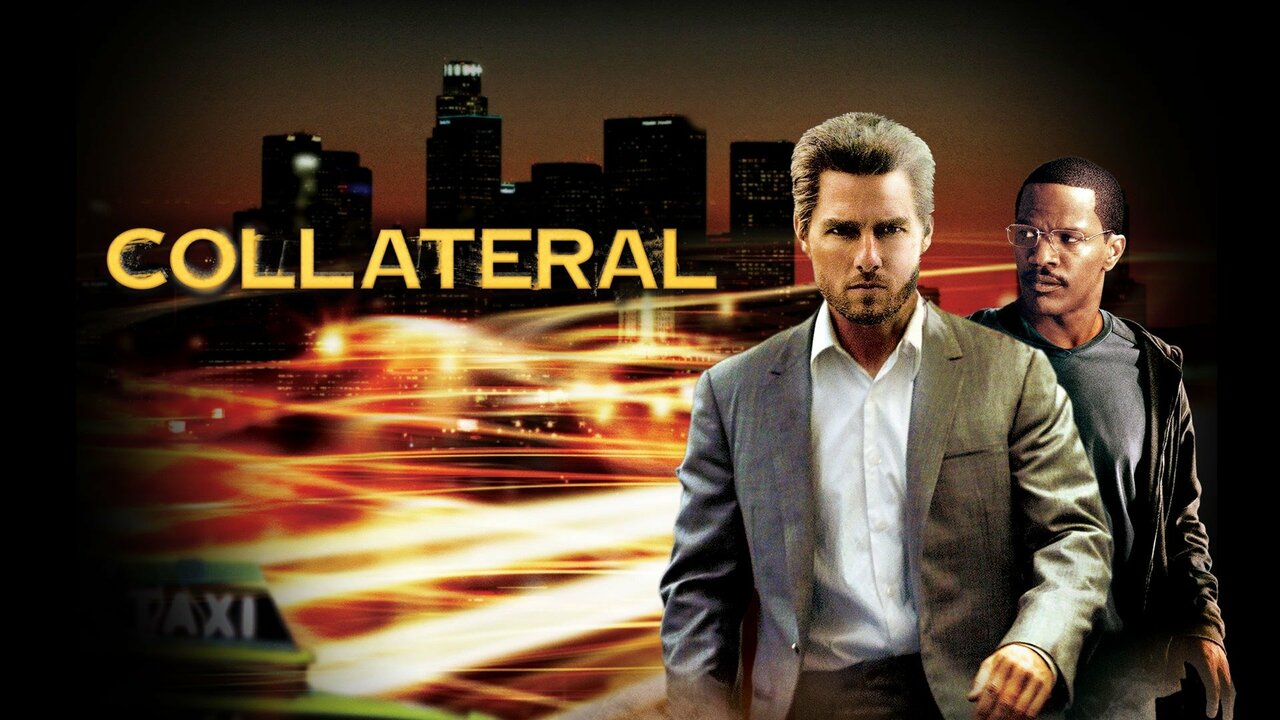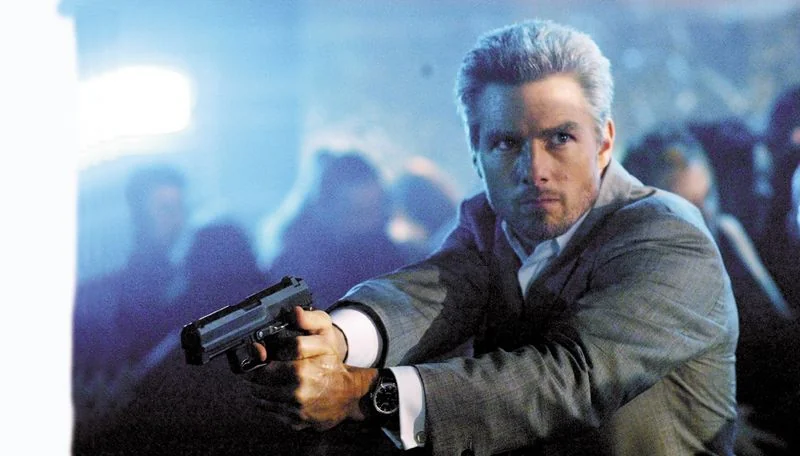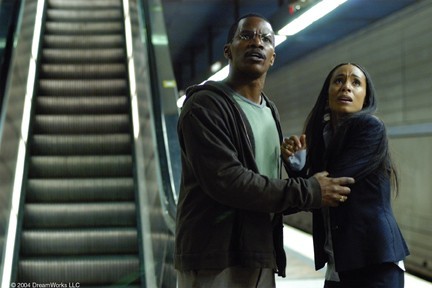COLLATERAL (2004)
- quoctinh
- November 11, 2024

Collateral (2004): A Night of Tension and Transformation in Los Angeles
Introduction
Collateral, directed by Michael Mann and released in 2004, is a neo-noir thriller that takes viewers on a tense, high-stakes journey through the streets of Los Angeles. Starring Tom Cruise and Jamie Foxx, the film follows a hitman and a cab driver thrown together by chance, forcing both to confront their beliefs and fears. With its stunning visuals, powerful performances, and a gripping plot, Collateral stands out as a unique exploration of morality, ambition, and chance encounters.
Plot Summary
The story centers on Max (Jamie Foxx), a meticulous, hardworking cab driver who dreams of owning his own limousine business. One night, he picks up a passenger named Vincent (Tom Cruise), who initially seems like just another fare but soon reveals himself as a ruthless contract killer. Vincent offers Max $600 to drive him around for the night, which Max reluctantly accepts. However, he soon realizes that Vincent’s “errands” are actually a series of assassinations.
As the night unfolds, Max becomes entangled in Vincent’s mission, forced to witness and even aid in these brutal acts to avoid Vincent’s wrath. They traverse the city’s underbelly, moving from one hit to another, all while the LAPD and FBI close in, led by detective Ray Fanning (Mark Ruffalo), who begins to piece together Vincent’s trail. Max and Vincent’s journey takes them from jazz clubs to abandoned warehouses, each location revealing more about their personalities and philosophies on life.
As the final showdown approaches, Max faces the ultimate test: Will he allow himself to be merely a pawn in Vincent’s plan, or will he fight back and risk everything to stop him?
Themes and Character Dynamics
Collateral explores themes of morality, chance, and transformation, positioning Max and Vincent as two fundamentally different men forced into each other’s orbits. Max represents the everyman who has been living on the sidelines, defined by his routine and dreams he hasn’t yet pursued. Vincent, on the other hand, is a cold, calculating professional who believes in self-sufficiency and has a grim view of humanity.
The interactions between Max and Vincent drive the film’s philosophical undertones. Vincent’s worldview is cynical and nihilistic, dismissing humanity as inconsequential. In one memorable scene, he compares people to “molecules” passing each other, questioning the significance of life and dismissing moral values. Max, by contrast, is compassionate, restrained, and deeply affected by the violence he’s drawn into. Their conversations reveal the contrast between Vincent’s fatalism and Max’s desire for purpose and meaning.
Throughout the night, Max is forced to confront his own passivity and self-doubt, with Vincent challenging him to take control of his life. This journey ultimately transforms Max, pushing him to stand up to Vincent, both for himself and for the lives of others. The film thus explores the idea that extreme situations can bring about profound personal change, forcing individuals to confront the limitations they’ve imposed on themselves.
Tom Cruise and Jamie Foxx’s Performances
Both Cruise and Foxx deliver standout performances, with Cruise cast against type as the villainous Vincent. Known for his roles as a charismatic hero, Cruise instead brings a chilling intensity to Vincent, portraying him as a relentless, almost predatory figure with an unsettling sense of calm. His transformation for the role — including his physical demeanor and the character’s meticulously gray appearance — adds layers to his portrayal, making Vincent a memorable and complex antagonist.
Jamie Foxx’s performance as Max is equally compelling. Foxx brings a quiet strength and vulnerability to the role, capturing Max’s internal conflict as he is forced into increasingly dangerous situations. Foxx’s portrayal of Max’s development — from a cautious cab driver to a man who finds his courage in a life-threatening crisis — earned him critical acclaim, including an Academy Award nomination for Best Supporting Actor.
Visual Style and Cinematography
One of Collateral’s defining features is its striking visual style, created by cinematographer Dion Beebe in collaboration with Michael Mann. Much of the film was shot digitally, a relatively new approach at the time that allowed for crisp nighttime visuals and realistic lighting. The digital cinematography captures the atmospheric, sprawling landscape of Los Angeles, portraying the city as both beautiful and isolating. Mann’s use of natural lighting — from the streetlights to the neon glow of LA’s skyscrapers — enhances the film’s noir aesthetic, immersing viewers in the shadowy, dangerous world that Max and Vincent navigate.
The film’s cityscape becomes a character of its own, with Mann utilizing LA’s diverse neighborhoods and architecture to add depth to the story. From the empty, sterile office buildings to the lively jazz club where Vincent briefly drops his guard, each location reflects different facets of Vincent’s and Max’s personalities. This nocturnal vision of Los Angeles as a place of hidden lives and unresolved dreams adds to the film’s moody, existential atmosphere.
Musical Score
The score for Collateral complements its intense and atmospheric tone, featuring a mix of ambient electronic sounds and a soundtrack that includes artists like Audioslave, Paul Oakenfold, and Groove Armada. The music underscores the film’s tension and reflective moments, heightening the suspense as Max’s ordeal unfolds. The sound of Audioslave’s “Shadow on the Sun” during a particularly intense scene contributes to the film’s introspective mood, capturing the sense of moral and personal conflict that permeates the story.
Critical Reception and Impact
Collateral was met with strong critical praise for its suspenseful storytelling, visual style, and standout performances. Critics highlighted Mann’s ability to blend action with character-driven drama, creating a thriller that is as much about introspection as it is about suspense. The film’s pacing and existential themes earned it comparisons to classic noir films, while Cruise’s and Foxx’s performances were hailed as among the best of their careers.
The film also had a significant impact on the neo-noir genre, influencing subsequent thrillers and action films with its use of digital cinematography, gritty realism, and thematic depth. Its portrayal of LA as both glamorous and lonely has since been echoed in numerous films that use urban landscapes to underscore their characters’ emotional journeys.
Conclusion
Collateral is a masterful thriller that combines pulse-pounding action with introspective character study. Through its compelling performances, innovative cinematography, and thought-provoking themes, the film stands as a unique entry in the crime genre. By exploring the unexpected bond between a hitman and a cab driver, Collateral examines how one night — and one fateful encounter — can transform lives. Michael Mann’s direction and the performances of Cruise and Foxx make Collateral a film that goes beyond the typical thriller, creating a suspenseful yet philosophical journey that leaves a lasting impression on audiences.











